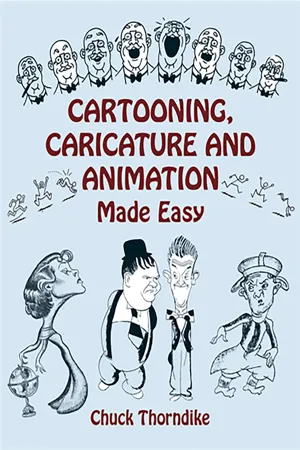
This is a test
- 80 pages
- English
- ePUB (mobile friendly)
- Available on iOS & Android
eBook - ePub
Cartooning, Caricature and Animation Made Easy
Book details
Book preview
Table of contents
Citations
About This Book
Written by an experienced teacher of cartooning, this volume combines The Secrets of Cartooning, the author's first and more elementary book, and The Art of Cartooning, his follow-up, in which he answered questions raised by readers of his earlier book. Each volume in this double edition is complete in itself as a series of lessons. The first part focuses on such basics as drawing the head, hands, and clothing; creating expressions; conveying motion; and obtaining shading effects. The second section presents a series of lessons in anatomy, followed by advice about drawing caricatures and detailed instructions for creating images for animated features and political cartoons.
Frequently asked questions
At the moment all of our mobile-responsive ePub books are available to download via the app. Most of our PDFs are also available to download and we're working on making the final remaining ones downloadable now. Learn more here.
Both plans give you full access to the library and all of Perlego’s features. The only differences are the price and subscription period: With the annual plan you’ll save around 30% compared to 12 months on the monthly plan.
We are an online textbook subscription service, where you can get access to an entire online library for less than the price of a single book per month. With over 1 million books across 1000+ topics, we’ve got you covered! Learn more here.
Look out for the read-aloud symbol on your next book to see if you can listen to it. The read-aloud tool reads text aloud for you, highlighting the text as it is being read. You can pause it, speed it up and slow it down. Learn more here.
Yes, you can access Cartooning, Caricature and Animation Made Easy by Chuck Thorndike in PDF and/or ePUB format, as well as other popular books in Art & Techniques d'art. We have over one million books available in our catalogue for you to explore.
Information
Topic
ArtSubtopic
Techniques d'artTHE SECRETS OF CARTOONING
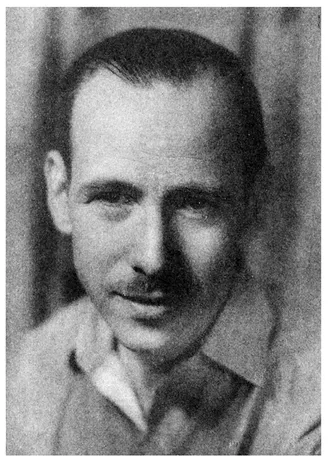
THE AUTHOR
The author of this little book has been drawing cartoons for over twenty-five years. Starting out as a contributor to high school publications, he then worked in a Seattle engraving shop, next on the San Francisco Bulletin, then drawing animated (movie) cartoons, and later in the Marine Corps he contributed to the “Leatherneck.” After the war, during three years of art school, he contributed to college publications. Then followed a trip to New York where he has served as art director for several advertising agencies and national magazines. He is connected with several newspaper syndicates, and contributes to the Saturday Evening Post, Life, Judge, College Humor, Ballyhoo, Hooey, and other magazines, including several foreign publications.
FOREWORD
This book is published as a much-needed and compact method of instruction for the ambitious art student and cartoonist.
Based primarily upon the experience of teaching hundreds of cartoon students throughout the country, its purpose is to fulfill most of their needs and answer their questions.
It is a fact, opinions to the contrary notwithstanding, that an accomplished cartoonist is, to a very large extent, his own boss. The amount of his success depends almost entirely upon his own talents, his ability to concentrate on his work, the confidence that the people he is working for hold in him — but probably most of all, the amount of satisfaction he or she gets out of doing a good job.
It is the hope of the author that the reader gets as much pleasure and benefit out of this book as he has had in preparing it.
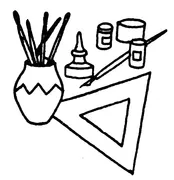
MATERIALS
It is obviously impossible to list all of the necessary materials here, but here are the items which are really fundamental necessities. Please remember that “a workman is only as good as his tools” — so the better the materials, the better the job. Note: See p. 58 for materials for advanced techniques.
WORK BENCH
DRAWING TABLE — A good-sized, adjustable-top table, about 40 inches by 30, is the handiest to use. However, if you can’t get this, use a thin-veneered drawing board (which won’t warp) on a table. Get a 75 or 100 watt BLUE GLOBE and keep this light above you and to your LEFT. (if you’re right-handed)
A TABOURET or stand should be at your right, with a shelf for your pencils, pens, brushes, colors, ink, water jar, etc. It should also contain drawers in which you keep some of your reference clippings.
PAPER
Use cold-pressed paper or BOARD, about 3-ply, for wash drawings. Hot-pressed or smooth-surfaced paper, whether kid or vellum, should be used for pen-and-ink work. Coquille paper or Ross board for sport or other drawings, requiring lithographic crayon. SCRATCH BOARD for working white lines on a black surface. (Thumb-tack your paper down when doing lettering and borders, using T-square and triangle — when sketching adjust the paper to suit your convenience.
PENCILS
Use a HARD pencil, #H or 3, about 5 inches long, with eraser attached, for lettering. Soft, 6B pencil, for sketching people, etc. Medium or #2 for preliminary drawing before inking in. Lithographic or “grease” pencil or crayon for gray-tone effects on sport drawings, etc. Blue pencil for indicating Ben-Day effects. White pencil for working on black paper.
PENS
Use a fine copper pen point for delicate line or “thick-and-thin” outline (adapt kind suitable to your touch). Use a small stiff or ball-pointed pen for small lettering (as in strips, etc.). A large round-pointed pen should be used for cartoon poster lettering or large “caps” in balloon talks, etc.
MECHANICAL INSTRUMENTS
A 5-inch ruling pen should be used for borders, etc. Have a 5-inch pen and pencil compass and a 3-inch pen compass handy. Also a 24-inch metal-edged ruler, an adjustable-head 24-inch metal-edged T-square, a 10-inch, 50-degree transparent triangle, a wooden pantograph (for enlarging pictures accurately and quickly).
BRUSHES
Get a large, red sable wash brush, several small #2 and #3 pointed camel’s hair brushes for small line work and filling-in, and a couple of #11 pointed camel’s hair brushes for “detail” wash work. (Use an old toothbrush for ink-spatter work. Rubber cement with paper stencil or cover with light glue that part of the drawing you don’t want spattered, then remove stencil or wash off glue, after spatter is completed.)
LESSON ONE ... THE HEAD
The head is the most frequently used and also the simplest form in cartooning. Therefore, the student should learn these proportions thoroughly before proceeding further. Although there is nothing difficult about the chart on the opposite page, it is too often abused due to carelessness.
The most important points are the SHAPE of the head and the PLACING and perfect BALANCE of the features. Can you draw a nice looking oval or egg-shape without much trouble? This may seem simple but you will be wise to practice sketching this simple form. After the oval is drawn, the next step is to locate the placing of the eyes which are on a horizontal line halfway (usually) between the top of the head and the bottom of the chin. Then draw your perpendicular line down through the center of the oval, to give the face an even BALANCE. Note that the ears are placed between the eyebrows and the bottom of the nose. From the side or profile view, you will observe that the head is square but that the features remain in the same relative position as in the front view. These rules are only a general guide in the construction of a head drawing and vary, of course, according to the subject you are doing.
To overcome difficulties you may have in drawing the head, copy the shapes on this lesson’s chart over and over again, until you have thoroughly mastered them — then draw them from memory. Make these heads from one-half inch to five inches in depth. When you do this correctly, it will develop that confidence of knowledge which is one of the first important steps in creative drawing.
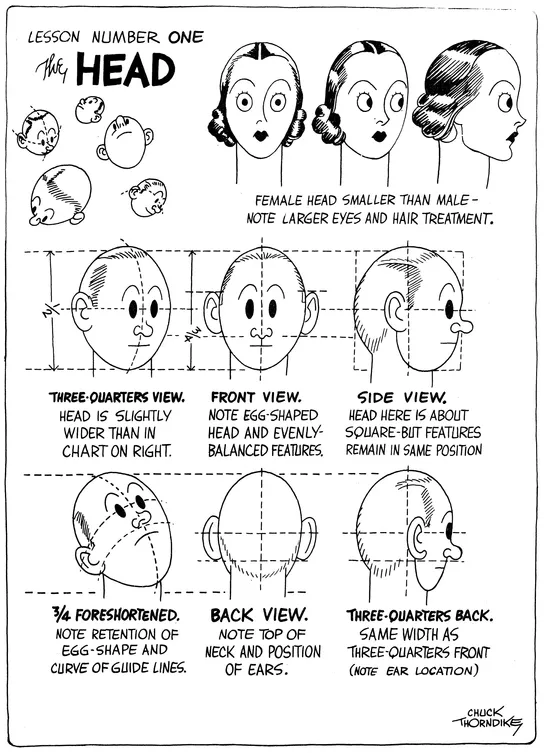
LESSON TWO... EXPRESSIONS
From the standpoint of putting “life” or “personality” into your cartoons the opposite plate on expressions and action is most important. There are times when the dumbest situation or gag can be saved by the expressions on the characters depicted. Try not to get meaningless lines in your faces but make every one contribute to the “type.” Don’t be afraid of careful exaggeration to emphasize a point but avoid careless distortion. Study the expressions on people’s faces and either sketch them or try to memorize them. Public assemblies are one of the best places to do this, or you can draw your own face in the mirror.
Also study the expressions on characters you see in the movies and make mental notes of them. Be sure to make your expressions fit the situation — as there is a subtle difference, at times, between facetiousness or weirdness and a really humorous effect. One of your best opportunities to get originality in your drawings is in the expressions on your characters.
As in all other lessons, draw and re-draw the expressions on this plate until you can do them perfectly from memory. Note particularly the difference between such expressions as fear, horror and surprise, anger and disgust, etc.
Make a particular study of the expressions on the faces of the animals in animated cartoons and then adapt them to your particular style. By this I don’t mean to “swipe” another artist’s treatment as this will only reflect on your work.
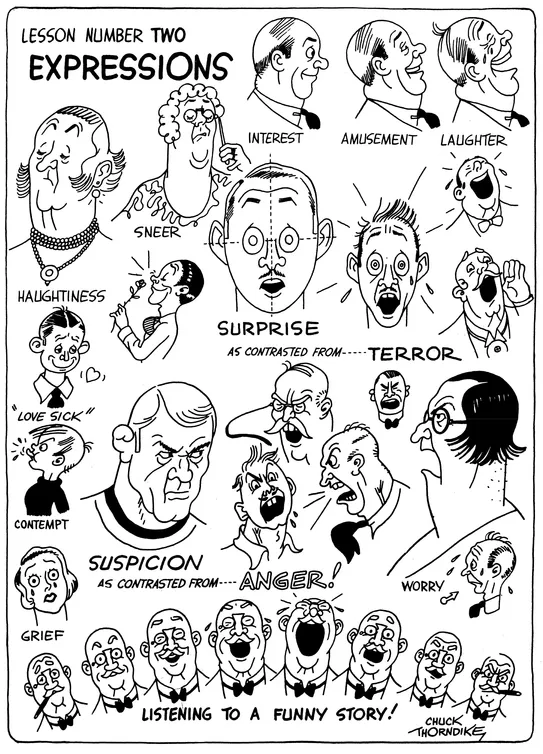
LESSON THREE ... ACTION
TO BECOME AN OUTSTANDING CARTO...
Table of contents
- Title Page
- Bibliographical Note
- Copyright Page
- Table of Contents
- THE SECRETS OF CARTOONING
- The Art of Cartooning
- LESSON TWO ... ANATOMY
- LESSON THREE ... ANATOMY
- LESSON FOUR ... ANATOMY
- LESSON FIVE ANATOMY
- LESSON SIX ... CARICATURES
- LESSON SEVEN ... CARICATURES
- LESSON EIGHT ... CARICATURES
- LESSON NINE ... CARICATURES
- LESSON TEN ... CARICATURES
- LESSOR ELEVEN ... TECHNIQUES
- ANIMATED CARTOONS
- LESSON TWELVE ... ANIMATED CARTOONS
- LESSON THIRTEEN ... ANIMATED CARTOONS
- LESSON FOURTEEN ... ANIMATED ... CARTOONS
- LESSON FIFTEEN ... POLITICAL CARTOONS